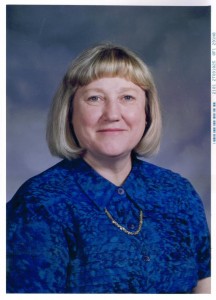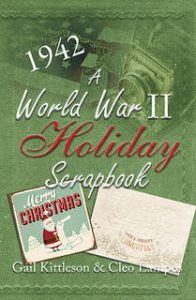Today I’m excited to welcome back my author friend, Cleo Lampos, and introduce you to her co-author, Gail Kittleson.
What do fiction writers do when the FACTS behind their stories overwhelm them? They decide to write a non-fiction book. Maybe even two of them!
That’s what Cleo Lampos and Gail Kittleson did last spring. The result, two short books delving into two facets of the World War II era—Food and Holidays—released on October 5.
For 26 years, Cleo Lampos used storytelling, biography and history to reach her classrooms of students in the public schools. Currently, she employs the same techniques to mesmerize senior citizens in community college extension classes.
With a Bachelor’s Degree in Education from University of Wisconsin-Whitewater and Master’s Degree in Special Education from St. Xavier University-Chicago, Lampos has written seven books and numerous magazine articles. She lives in the Chicago area where she quilts, joins her husband in urban gardening, and enjoys her eleven grandchildren.
Visit Cleo online at: Cleo Lampos.com
FB: Author Cleo Lampos
Cleo’s an expert researcher, and Gail’s love for this era has grown into an addiction. There’s so much to explore, and the real-life characters are so intriguing. These men and women from the 1940’s faced impossible challenges with tenacity, courage, and a faith that puts mine to shame.
We have so much to learn from these make-do folks, called from their farms and factories and homes to make a difference. Banding together, they certainly did—their ingenuity and creativity astound me!
For example, did you ever hear of potatoes being used as weapons? Well, the Navy found a way! Spuds proved to be instrumental in the war effort on several levels.
The fortitude of the people on the home front is astounding. Their resourcefulness in creating food from their Victory Gardens, bringing the spirit of Christmas to their children with few resources, and the sacrifice of basic needs for the boys overseas is inspiring.
With grainy photographs and heart wrenching snapshots, these two non-fiction books will bring WWII to life in a way that will make the reader agree: they were the Greatest generation.
Words have always been comfort food for Gail Kittleson. After instructing expository writing and English as a Second Language, she began writing seriously. Intrigued by the World War II ear, Gail creates women’s historical fiction from her northern Iowa home and also facilitates writing workshops/retreats.
She and her husband, a retired Army Chaplain, enjoy their grandchildren and in the winter, Arizona’s Mogollon Rim Country. You can count on Gail’s heroines to ask honest questions, act with integrity, grow in faith and face hardships with spunk.
Visit Gail on line at http://www.gailkittleson.com/
@gailkittlesonauthor (Instagram)
Excerpt from the Christmas book
That Homesick Feeling
“Home for the traditions. Instilled in each person are the customs of their family, community and religion. The familiarity of performing the same ceremonies each year brings security. The lighting of the Christmas tree, ice skating at the pond on Christmas Day, exchanging gifts, baking special cookies, candlelight, or bringing in pine laden branches to decorate.
As the soldiers lay on their cots or kept their heads down in a foxhole, these traditions waved over them with eye watering memories.
Home for the sounds of Christmas. Fortunately, the Armed Forces Radio Services with Bing Crosby produced programs and music for the troops. Songs like White Christmas, Chestnuts Roasting on an Open Fire, Have Yourself a Merry Little Christmas, and Happy Holidays brought the nostalgia of home to the front, producing a melancholy sing-along for many.
The music of the season also varied with the home town of the military personnel. Those from the big cities missed hearing the orchestras play Handel’s Messiah. Small town soldiers longed for the school pageant with young siblings dressed in bathrobes singing Away in a Manger. From the Appalachian Mountains, the strum of a dulcimer bringing I Wonder as I Wander to life would have brought peace to a sailor. Many missed carolers in the streets, singing hymns from door to door.
Home for the church services and family. Christmas Eve and Christmas morning were times when the family dressed up and attended church together to ponder the meaning of the season.
For those entrenched overseas in the war, there would be no Christmas truce like there had been during the First World War. Especially in 1944, American soldiers hunkered in and celebrated the best they could during the Battle of the Bulge and the Siege of Bastogne.
For American soldiers within Bastogne, Christmas services were held by the Army Chaplain. For the soldiers on the battlefield outside the city limits, their hearts became the sanctuary for worship and remembrance of the birth of the Prince of Peace. Even in the midst of shelling, they took time for personal reflection on the meaning of the day.
Belgian families took in some troops. “We were out in the outskirts of Bastogne, we found this farmhouse…Inside was a man and woman, and a little boy and a little girl…the wife, she gave us some soup and black bread. We stayed there all night in this farmhouse. The war was going on fiercely outside, (but) the farmhouse never got hit. We were there Christmas Eve. We sang Christmas songs with this Belgian family: Jingle Bells and Silent Night. The words were different, but the music was the same.”1
In the simplicity of sharing, the true spirit of Christmas filled these soldiers with comfort and hope.
On December 24, 1942, Rev. Fred Gehring, a Catholic priest from Brooklyn, New York joined Barney Ross, a Jewish boxer from Chicago to bring hope and build morale. Amid the foxholes of Guadalcanal, Gehring and Ross held a midnight Mass service for their fellow soldiers in B Company, 1st Battalion, 8th Marine Regiment. Ross learned to play Christmas carols on a violin, and Gehring tickled the ivory on an organ. Men from so many different stations and backgrounds sang in unison, making this a Christmas Eve to remember because the birth of Jesus brings the promise of an eternal home after this earthly home has ended.2
Meanwhile, the most frequently sung tune during the war only intensified the lonely, empty feeling of being separated from all that had been familiar. As Bing Cosby crooned, tears fell on the home front as well as overseas.
A Short Review
These are two wonderful books that I think everyone will love, especially of you’re into nostalgia. But even if you’re not, reading about what it was like for the solders to scrounge for food, and how moms fed their families at home on what little they could get to eat was fascinating. Food was not only important to the solders and the moms at home, but the nurses overseas who had to feed themselves and the wounded as well.
The Holiday Scrapbook captures what it was like not only for the solders, but also families on the home front at Christmastime in 1942. I can’t begin to get into all the marvelous information that’s packed into these two small books, you’ll just have to read it all for yourself. And the pictures are absolute gems.
These slim volumes complement each other and are loaded with recipes from that era. So get your copies today. I think they would make excellent Christmas gifts.


